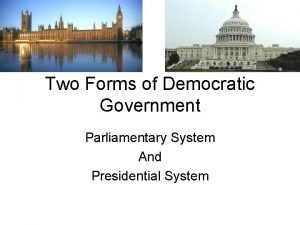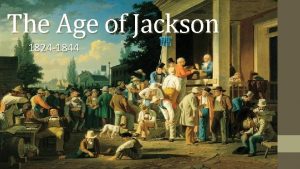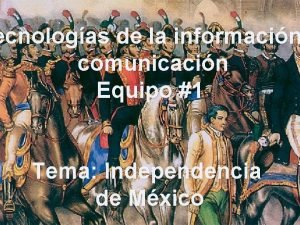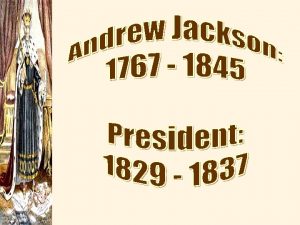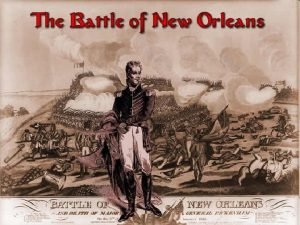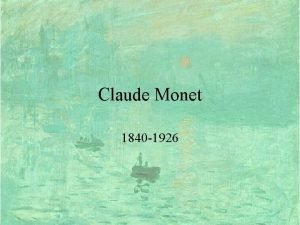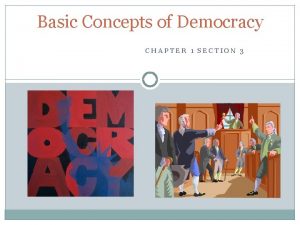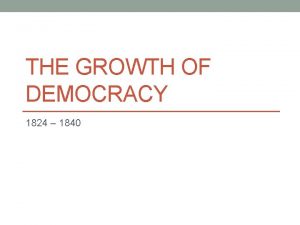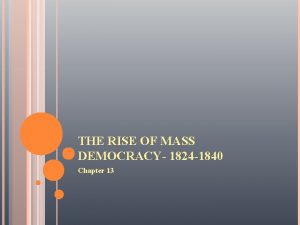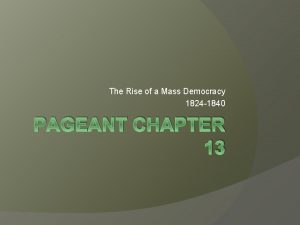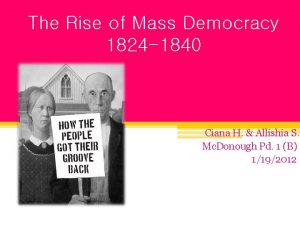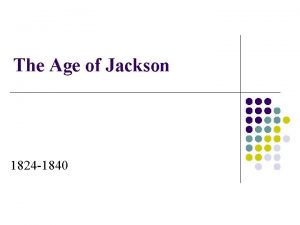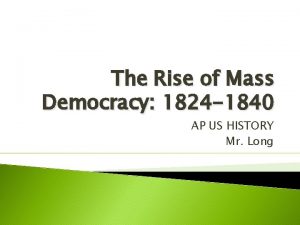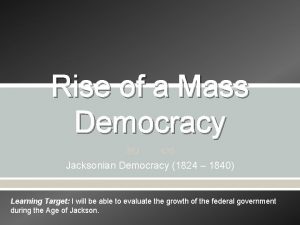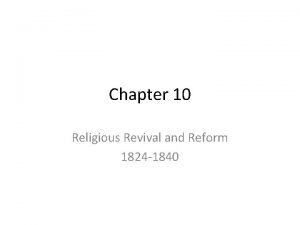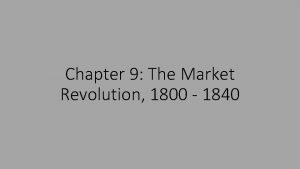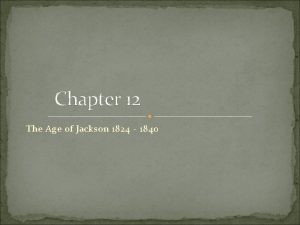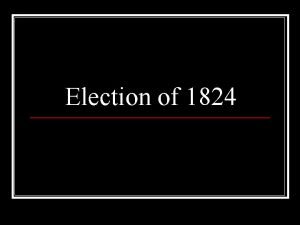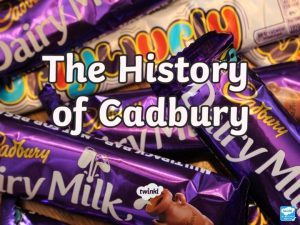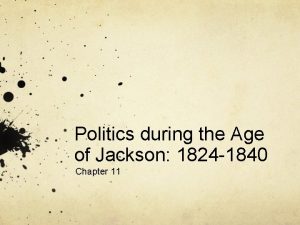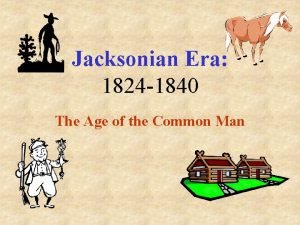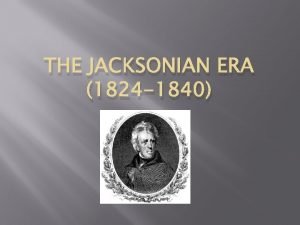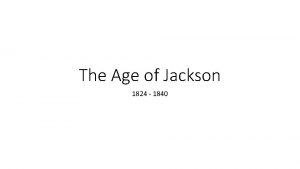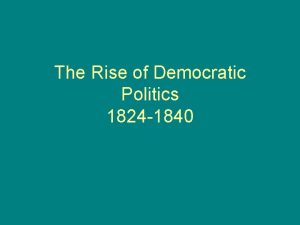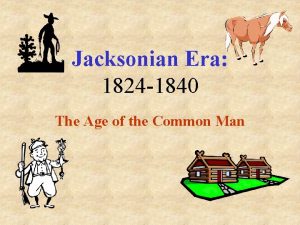Chapter Ten The Growth of Democracy 1824 1840





































- Slides: 37

Chapter Ten The Growth of Democracy, 1824— 1840

Part One Introduction

Focus Questions What was the role of Andrew Jackson’s presidency in affirming and solidifying the new democratic politics? What part did the transportation revolution play in unifying the nation? How was the basic two-party pattern of American political democracy established? How did writers and artists and their audiences create a distinctive American cultural identity?

Part Two Martin Van Buren Forges a New Kind of Political Community

Martin Van Buren Forges a New Kind of Political Community The son of a tavern keeper, Martin Van Buren lacked the aristocratic connections necessary for political advancement in New York. Van Buren built a democratically controlled, well-disciplined party organization that brought him political power.

Part Three The New Democratic Politics in North America

Continental Struggles over Popular Rights In 1821, Mexico won independence from Spain. Santa Anna was the strongest early president assuming dictatorial powers, but was in office when Texas and northern provinces were lost to the United States. In Haiti, independence destroyed the sugar industry. The British Caribbean islands experienced numerous revolts leading to the abolition of slavery and the subsequent decline of the sugar industry. A revolt in 1837 by Upper and Lower Canada led to the union of the two regions to make the Frenchspeaking population a minority.

The Expansion and Limits of Suffrage Map: Population Trends: Westward Expansion, 1830 While the population of the United States more than doubled between 1800 and 1830, the trans-Appalachian population grew tenfold.

The Expansion and Limits of Suffrage Map: The Growth of Universal White Suffrage In 1800, only white, male, property owners could vote in most states. As new western states came into the Union, suffrage expanded. By 1820 most of the older states had dropped property qualifications. By 1840, 90 percent of adult white males could vote. Women and African Americans were barred from voting.

The Election of 1824 Map: The Election of 1824 The 1824 election marked an end to the political truce of the Era of Good Feelings. Four candidates ran for the presidency. Though Andrew Jackson had the most popular votes, John Quincy Adams won as a result of the so-called “corrupt bargain. ” Hostile relations with Congress block many of Adams’s initiatives.

The New Popular Democratic Culture A more popular form of politics was emerging. New state organizations increased political participation and helped elect Andrew Jackson president. New techniques of mass campaigning encouraged increases in participation.

The New Popular Democratic Culture: The Print Revolution Table: The Burgeoning of Newspapers The print revolution was most evident in the growth of newspapers. It also helped democratize politics by publicizing the new political pageantry. Tightly-organized, broad-based political groups emerged. Party loyalty among politicians and the public was stressed as politics became a feature of everyday life.

The Election of 1828 Map: The Election of 1828 In the 1828 election, Jackson triumphed as his supporters portrayed the contest as a struggle between democracy and aristocracy. His victory showed the strength of the new popular democratic culture and system of national parties made up of a coalition of the North, South, and West.

Part Four The Jackson Presidency

A Popular Figure Jackson symbolized the personal advancement that the frontier offered. His inauguration brought out a mob of wellwishers whose unruly behavior led critics to fear that this was the beginning of the reign of “King Mob. ”

A Strong Executive Jackson’s Democrats created a national coalition that transcended sectional identity. Jackson was a strong executive who consulted with the “Kitchen Cabinet, ” largely ignoring his cabinet. Jackson strengthened the presidency by using the veto more frequently than had all of his predecessors combined. His most famous veto of the Maysville Road Bill of 1830 was a defeat for western rival Henry Clay.

The Nation’s Leader versus Sectional Spokesmen Regional spokespeople included: Daniel Webster for the East; John C. Calhoun for the South; and Henry Clay for the West. Jackson overrode sectional interests and had national appeal.

The Nullification Crisis Constitutional ambiguity, sectional interests, and the states’ rights issue caused political controversies. The 1828 “Tariff of Abominations” elicited a strong reaction from South Carolina. Southerners argued that the tariff was an unconstitutional effort to enrich the North at southern expense. John C. Calhoun wrote a defense of the doctrine of nullification claiming states could refuse to enforce laws they deemed unconstitutional. South Carolina nullified the 1833 tariff and threatened to secede. Jackson considered South Carolina’s action treason and passed the Force Bill. Henry Clay engineered a compromise tariff that ended the threat of civil war.

Part Five Changing the Course of Government

Indian Removal Map: Southern Indian Cessions Jackson embraced the policy of Indian cession of their lands and removal west of the Mississippi River. The five civilized tribes of the South were most affected. Even though the Cherokee had adopted white ways and accepted white culture, Jackson pressed for their removal. Jackson defied the Supreme Court ruling in favor of the Cherokee. The Cherokee removal was called the“Trail of Tears. ” The Removal Act of 1830 was strongly opposed by northerners.

Internal Improvements By 1850, rivers, canals, road, and railroads tied the nation together. The transportation revolution dramatically reduced travel times and connected people to the outside world. States provided more funding for roads, canals and railroads than the federal government.

Legal Support for Private Enterprise The Supreme Court fostered economic growth by: asserting federal power over interstate commerce; and encouraging economic competition by denying monopolies. State laws enabled businesses to protect themselves by granting charters of incorporation.

The Bank War Chartered in 1816, the Second Bank of the United States was a quasi-private institution. The Second Bank acted as a currency stabilizer by: encouraging the growth of strong and stable financial interest; and curbing less stable and irresponsible ones. Eastern merchants found the bank a useful institution. Western farmers and speculators feared the Bank represented a moneyed elite. Jackson vetoed the bill when Clay and Webster pushed for early re-chartering.

Jackson's Reelection in 1832 In the election of 1832 Jackson soundly defeated Henry Clay. After his victory, Jackson withdrew federal deposits and placed them in “pet” banks. Jackson claimed that he was the direct representative of the people and could act regardless of Congressional opinion.

Whigs, Van Buren, and the Election of 1836 The Bank called in commercial loans, causing a recession. Jackson’s opponents founded an opposition party —the Whigs. The new party lost the 1836 election to Martin Van Buren.

The Panic of 1837 The death of the Bank led to feverish speculation and the Panic of 1837. The depression that resulted led to great hardship giving the newly formed Whig Party its opportunity.

Part Six The Second American Party System

Whigs and Democrats: Organized to elect Jackson to presidency in 1828 Party spoke for Jeffersonian democracy, expansion, and the freedom of the “common man” from interference of the government of financial monopolies It’s power base lay in the rural South and West and among northern urban workers

Whigs and Democrats Whigs: Organized in opposition to Jackson in early 1830 s Heirs to Federalism, they favored strong role for national government in economy and supported active social reform It’s power base lay in the North and Old Northwest among voters who benefited from increased commercialization and among southern planters and urban merchants

The Campaign of 1840 Map: The Election of 1840 In the election of 1840 Whigs portrayed their candidate, William Henry Harrison, as a humble man happy to live in a log cabin. The Whigs won a sweeping electoral victory in a campaign with 80 percent voter turnout.

The Whig Victory Turns to Loss: The Tyler Presidency The Whig triumph was short-lived as Harrison died a month after his inauguration. Vice. President John Tyler assumed office. A former Democrat, Tyler vetoed a series of bills calling for a new Bank of the United States, tariffs, and internal improvements. The Whigs were unable to bridge the gap between North and South.

Part Seven American Arts and Letters

Popular Cultures and the Spread of the Written Word Steam-powered presses, the transportation revolution, and the telegraph helped facilitate a communications revolution. Newspapers and almanacs fostered popular culture.

Creating a National American Culture An intellectual movement was stimulated by eastern societies and journals. Washington Irving, James Fenimore Cooper, and especially Ralph Waldo Emerson created a distinctly American culture.

Artists and Builders Artists such as Albert Bierstedt and George Caleb Bingham drew upon dramatic themes from the American landscape and lifestyles. Neoclassical remained the architectural style for public buildings. Balloon frame construction enabled Americans to build homes at a rapid clip.

Part Eight Conclusion

The Growth of Democracy, 18241840 Media: Chronology
 V cc
V cc Kể tên các môn thể thao
Kể tên các môn thể thao Presidential vs parliamentary
Presidential vs parliamentary Romantic period 1798 to 1832
Romantic period 1798 to 1832 Website to access accenture delivery suite(ads)
Website to access accenture delivery suite(ads) Guided reading & analysis: the age of jackson, 1824-1844
Guided reading & analysis: the age of jackson, 1824-1844 Constituição 1824
Constituição 1824 The romantic age (1798 to 1824)
The romantic age (1798 to 1824) 19 estados y 5 territorios de méxico en 1824
19 estados y 5 territorios de méxico en 1824 Mexican constitution of 1824
Mexican constitution of 1824 The age of jackson 1824-1844
The age of jackson 1824-1844 Moses austin symbol
Moses austin symbol What is the main idea?
What is the main idea? Hume foreclosures
Hume foreclosures Election of 1824
Election of 1824 We took a little trip down the mighty mississippi
We took a little trip down the mighty mississippi Voto censitário
Voto censitário Hartley v ponsonby
Hartley v ponsonby Liebig 1840
Liebig 1840 Segundo reinado 1840 a 1889
Segundo reinado 1840 a 1889 Fue descubierto y nombrado por schoenbein en 1840
Fue descubierto y nombrado por schoenbein en 1840 Claude monet 1840 1926
Claude monet 1840 1926 Ten twenty thirty worksheet
Ten twenty thirty worksheet Ten ten siempre fuerzas y esperanza
Ten ten siempre fuerzas y esperanza Ten ten program
Ten ten program Define growth analysis
Define growth analysis Monocot vs eudicot
Monocot vs eudicot Growthchain
Growthchain Primary growth and secondary growth in plants
Primary growth and secondary growth in plants Chapter 35 plant structure growth and development
Chapter 35 plant structure growth and development Geometric growth vs exponential growth
Geometric growth vs exponential growth Neoclassical growth theory vs. endogenous growth theory
Neoclassical growth theory vs. endogenous growth theory Organic vs inorganic growth
Organic vs inorganic growth Chapter 7 citizen participation in a democracy answers
Chapter 7 citizen participation in a democracy answers Chapter 13 the rise of a mass democracy
Chapter 13 the rise of a mass democracy Chapter 12 lesson 1 jacksonian democracy
Chapter 12 lesson 1 jacksonian democracy 5 basic concepts of democracy
5 basic concepts of democracy Dryfus affair
Dryfus affair


